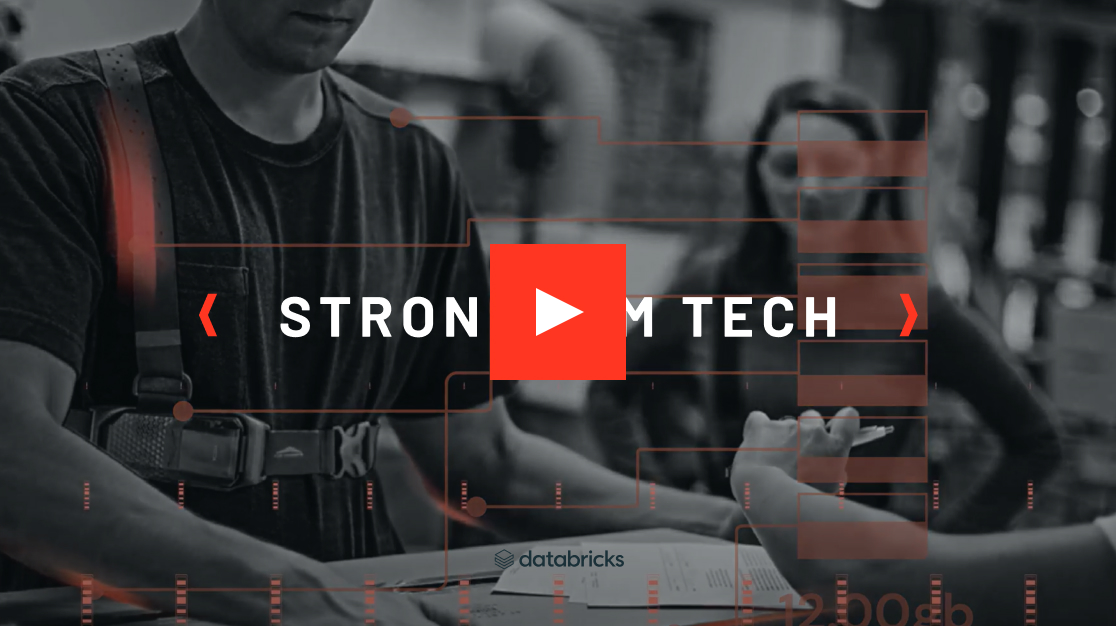Product descriptions:
Many industrial injuries don’t happen overnight. They develop slowly, over long periods of repetitive harmful motion, ultimately leading to physical damage that can, in worst cases, be irreparable. StrongArm Tech is tackling this problem with wearable devices that track daily motion and activity as well as the wearer’s immediate surroundings. With Databricks, they are able to ingest massive amounts of real time IoT data for downstreaming machine learning that provides proprietary Safety Scores and classifications of activities to predict risk, resulting in a smarter, safer environment: StrongArm has been able to reduce industrial workplace injury rates by over half, and deliver millions in health and insurance cost savings for both their customers and their customers’ employees.
The complexity of leveraging data to improve workplace safety
Industrial injury is a big problem that can have significant cost implications, not only for the employer but also for the employees who must bear the brunt of medical costs.
“Lower-back injuries are the most common types of injury in the industrial workspace. Every time a worker gets injured, it typically costs more than $65,000 in terms of medical expenses,” explained Bryant Eadon, CIO at StrongArm Technologies.
StrongArm’s goal is to capture every relevant data point—roughly 1.2 million data points per day, per person—to predict injuries and prevent these runaway costs from occurring. With such large volumes of time-series data flowing in real time, they struggled to build reliable and performant ETL pipelines that could scale to meet data science needs. Maintaining infrastructure also required significant resources, often taking an entire week to provision clusters that were stable enough to handle their workloads.
From a data science perspective, working from a single laptop proved to limit their ability to efficiently perform ad hoc queries and weren’t able to train their models against their entire datasets.
Across the various data teams, collaboration among both systems and personnel was challenging. Data professionals already struggle with collaboration as teams are often siloed, their jobs historically being less about cross-pollination and more about urgency, but without the right tools to foster the teamwork needed, it just exacerbated the situation.
A unified data lake and streamlined machine learning lifecycle
With the Databricks Data Intelligence Platform, iteration and collaboration are no longer an issue as data engineering, data science and the analysts are able to more easily work on the data together.
Delta Lake solved their data reliability issues, allowing them to easily ingest real-time IOT data from various sources with ease. With data pipelines flowing seamlessly to the data science team, the data science team was able to more easily innovate with machine learning. MLflow streamlined the entire machine learning lifecycle, to ensure the best models make it to production.
“Before Databricks, I had no way to structure my data science research project. If I had a model and iterated 20 times, I would forget what the results for my first model were, so I would have to dig through so much,” said Siva Bommireddy, Data Scientist at StrongArm. “MLflow makes that easier to manage, and solves for the iterative nature of data science in general.”
The last group to benefit from the unification of data across the organization was the analyst team. Matt added that being able to produce results for non-technical teams has been incredibly fulfilling. “I can actually deliver results that make sense to all teams, data-specific or not, within 15 minutes,” he said. “Databricks has solved so many data use cases.”

Behind the story: The Data Team Effect
60% reduction in injury resulting in over $5M in cost savings
StrongArm is now able to unlock insights from their sensor data, translating into new strategies their customers can employ to potentially improve workplace safety and the livelihoods of their employees.
After performing a deep dive analysis of one of their largest Fortune 100 customers, StrongArm measured a reduction of workplace injury by up to 60%, delivering a 355% ROI on $5,347,368 in gross savings. At the same time, StrongArm has been able to reduce the margin of error for evaluating injury risk from 23% to just 5%—an improvement of 78%.
“We are in the business of protecting the Industrial Athlete.,” explained Eadon. “Databricks allows us to unleash the power of data and machine learning to help workplaces become safer, more productive, and a better environment for tens of thousands of industrial workers that we count on in our own everyday lives.”

Embark’s data analysts leverage internal metrics and generate dashboards via Tableau to better understand how their software and sensors are performing. Today, their data analyst team has a number of Tableau dashboards running — all powered by Databricks — including the performance of their software versions, sensor calibration performance, and more.